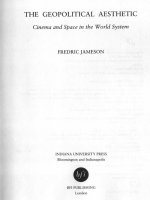Different Legal Systems in the World
Bạn đang xem bản rút gọn của tài liệu. Xem và tải ngay bản đầy đủ của tài liệu tại đây (112.8 KB, 29 trang )
Different Legal Systems
in the World
A-
Common Law System (English Legal
System)
B- Civil Law System (Continental SystemRomano-Germanic Family)
Other Systems
–
–
Sui generis systems
Mixed systems
Common Law System
(English Legal System)
Common Law System
Occurred
historically in England-----mostly
because of the result of decisions and
activities of the Royal Courts of justice
following the Norman Conquest (11th
Century).
Most of the English-speaking countries---not
all of them---are considered as countries
having this system (examples)
General Characteristics
1- Common Law is an unwritten law.-----formulated
mainly by judges. It is case-centered and judgecentered.(scope for discretionary)
2- Main aim is to find and provide pragmatic
solution to particular specific trial/problems----not
to seek a general rule of conduct or general
principles law for the future
3- It is more concrete and less abstract if you
compare it with Civil Law System.
4- It is mainly a public law system.
5- The basis for Common Law System is English Law
History of English Common Law
During Anglo-Saxon times:
– no experience --transformed mostly because of the social needs.
– Local customs dominant until the 11th Century---customs varied
from place to place ---no common law for whole of England.
– The Anglo-Saxon system of keeping the peace (system of
security)--was based on Borh ---This was a police organization
which required every male to belong to a group of ten or more
persons under a headman.
– All persons in the group were mutually responsible for the offences
of the others and were bound to bring the offender before the court if
called upon.
– The group would back up this pledge (promise) by paying the fines
of its members if they were found guilty of violating customary law.
– borh system was replaced after 1066 by the related but distinct and
non-voluntary system called “frankpledge” system.
History of English Common Law
Before
the 11th century---- there was no
strong central government and the King
(with his council) ruled loosely and controlled
his kingdom inefficiently-----Royal justice was
difficult to obtain.
Following the 11th Century----Normans
period started when William of Normandy
gained the Crown of England (1066)
Normans Period
1- They stopped the rebellious groups and they changed the
form of administration and caused a strong centralized
administrative body----King’s Council (Curia Regis)---barons
+ bishops + and other important figures of the Kingdom.
2- New military and centralized feudal system:
–
–
–
King---owner of all land
Lords, barons, bishops----tenant or sub-tenant
To swear an oath of allegiance----Royal control
3-Separation of lay courts and church (clerical) courts
4- For important cases for the continuation of peace in
England----the King exercised “high justice” exceptionally.
–
King’s Court--- or King’s Council-----called “Curia Regis”
History of English Common Law
Curia
regis performed legislative, executive
and judicial functions together
–
–
–
a court for the most important personalities and
disputes.----It was not open to ordinary citizens
From the 13th Century-----some parts of Curia
Regis was transformed into Royal Courts which
were located at Westminster
limitations on the power of Curia Regis deriving
from the “prerogatives of the local feudal barons”
History of Common Law
Royal courts had the power to intervene in the
domain of barons exceptionally.
Matters related to royal finance
Problems of respecting ownership and possession of land
Serious criminal matters affecting the peace of the kingdom
Royal Courts were paid fee----caused eagerness to
hear more and more cases
differences between the procedures applied in royal
courts and in local courts
Procedure in local courts was arbitrary and outdated
Royal courts had instruments such as calling (summon)
witnesses and enforcing their judgments
History of Common Law
As a result----Royal courts became the only court of
justice in England
But until the 19th Century---to bring a case before
a Royal Court was not a “right” for citizens but it
was a favor that can be granted by the Royal
authority:
a citizen had to brought a request to the Chancellor (judge)
asked from him to deliver a “writ”-(an order issued by a court
or by an administrative body--Mahkeme emri-mahkeme ilamı)
Writs were entitling and enabling the royal courts to accept
and analyze the issue following the payment of required fees
History of Common Law
not only an authorization for
a citizen to bring a case---but also a kind of order
given by the king to his
officer to enforce the
decision
The writ entitled the
defendant and plaintiff to
attend the royal courts at
Westminster on a certain
date
Plaintiff: for civil cases----a person
who brings the case to the court.
Defendant: for civil cases----the
person against whom the claim is
brought into the court.
Accused person: In criminal
cases----- the person against whom
the claim is brought into the court.
Person injured: In criminal
cases----- a person who brings the
case to the court.
History of English Common Law
Royal judges were granting better justice----when they visit a county
court (shires became county after the Norman conquest)------they had to
determine the customs applicable to the local court.--------royal judges
than applied the law that discovered from the inhabitants.
12 and 13th Centuries----the introduction of juries.------juries were made
up of local people who knew the facts of the local cases and the
relevant local custom
Jury decides on the facts of the case, the judge determines the law
(values of the society + randomly selected)
–
–
–
–
(Exceptionaly in France as well only on criminal cases)
Canada only for serious crimes
England and Walescriminal cases and a few civil cases
Most US both civil and criminal cases
History of Common Law
another important practice grew up---the principle of
stare decisis (Rule of Precedent).
–
–
–
–
Maintain what has been decided and don’t alter the
established----The principal that the precedent decisions
are to be followed by the courts
whenever a new problem of law came to be decided---a rule
was formed ----and this rule was followed subsequently by
all other judges
Law become more predictable and more certain
As a result of this----the common law of England was
formed and it was called like that because-----it was the law
common to all parts of England (following 1707 UK).
History of Common Law
Writs:
procedural steps occupied a crucial
importance Substance was ignored and
the main aim was to achieve solutions to
disputes by procedures
In contrast to the Romano-Germanic
family----common law system did not
attempt to find justice.
Supremacy was given to the matters of
procedure in English law
Writ
For every civil wrong and cause of action-----there was a
separate writ.-----A writ was purchased from the main royal
office.
A plaintiff applied for the writ most suitable to his claim.-----If
there was no writ suitable to a civil claim---------the plaintiff was
at a severe disadvantage.
If the plaintiff selected the wrong kind of writ---------the common
law judges would throw out the case and refrain from
inquiring into its merits.
Creating new writs was prohibited at the beginning.---------As
a result certain wrongs went un-remedied------merely because
they did not fall within the limits of an existing writ.
History of English Common Law
Because of the dominance of procedure in English
law (remember writs) it was difficult for the
Common Law System to meet the changing needs
of the English society. Day by day it was
paralyzed.---number of “just solutions” declined.
From the 14th Century---persons obtaining unjust
solutions from the Royal Courts or shocked by
these solutions-----appealed to the King and invited
him to intervene
History of English Common Law
Such appeals became institutionalized and established set of rules
separately from the Common law system.-------power and authority of
the King was delegated to the chancellor to judge these case on
behalf of the King----thus these events led to the emergence of the
“Court of Chancery”.
Judgments of the chancellor were based on the “equity of the cases”
and this approach created the “principle of equity” or “the equity
doctrine”----which can be considered as corrections (and additions)
to the principles applied by the royal courts.
Existence of common law and equity law in 17th Century was the
main feature of English law
a dual system of law------Common law formed the main body while
the function of equity law was to complete and correct the Common
Law.
English Legal System
In Romano-Germanic Family there was and there is
a distinction between public law and private
law------But in English law distinction is occurred
not between these laws but between “Common
law” and “equity law”
Main principle: “equity follows the law”---means
common law.
Since the 19th Century common law and equity law
have been both administered by the same courts
Common Law
But
still there are two different procedures
for “equity” and “common law”-----but the
main difference between the two is related
with the branches they include:
Exp:
–
Equity in the law of property
Unjust enrichment, title, possession, joint ownership
Sources of English Law
Primary Sources
1-court decisions (“common law” and “equity law”)
2-legislation
Subsidiary Sources
3-custom
4-legal writing (doctrine)
English law is basically a “case law”.----a judgemade law.-----Main source is court decisions
Sources of English Law
In all countries there is distinction between “superior courts”
and “all other courts”. All other courts---are called as “lower
courts” or “inferior courts”
Superior courts contribute the development of common law
and equity.----superior courts create the legal rules
In England----rules set by court decisions must be followed by
other courts.-----normally common law system is a judge-made
system and judges have a basic obligation to respect the
“judicial precedent”—example-instances----they should
respect the previous court decisions and this is called “the rule
of precedent”
Sources of English Law
Advantages
of case-law approach:
Certainty
Predictability
Uniformity
Disadvantages
Binding
of case-law approach:
force of the precedence limits the discretion of
the judge
Sometimes inconsistent rules are developed and come
into conflict
Law reports---legal rules are difficult to learn and apply
Sources of English Law
To overcome clear conflict---superior courts may, on
appeal:
–
–
–
Overrule a decision: Appeal court decides a similar case
on the basis of a different rule---previous rule is said to be
overruled.
Reverse a decision (reversal): Appeal court reverses a
decision given in a lower court—related to the same
case----but this time in favor of another party.
Disapprove a decision (disapproval): Appeal court
expresses doubt about the validity of a previous rule, but
does not expressly overrule it. It applies another rule.
Sources of English Law
In UK:
– All Courts are bound by all decisions of;
House of Lords (Now Supreme Court of the UK-2009) (UK Welsh
Scothland Northern Ireland). Not anymore House of Lords
Court of Appeal (Civil Division and Criminal Division
Second Source: Legislation
–
–
–
British Parliament: House of Lords & House of
Commons
Main legislative source----Acts of Parliament/Statutes
Delegated legislation/subordinate legislation
Sources of English Law
No
written constitution in UK (it has uncodified
constitution) , but;
–
–
–
Some set of laws and principles enacted by
Parliament or judicial decisions and international
treaties.
They guarantee fundamental rights and
freedoms of individuals----limit the arbitrary
exercise of power by the executive organ (1215Magna Carta)
Parliamentary sovereignty









